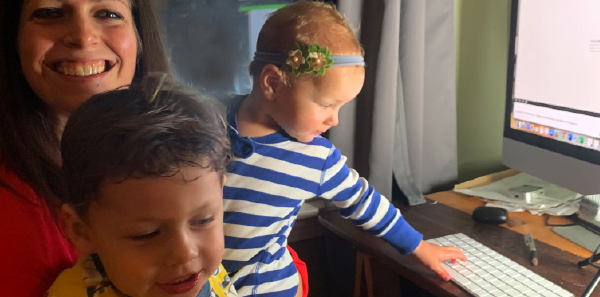
Since the pandemic began, virtual meetings have become the new normal. As a mother of two children under five years of age (and one on the way), I have been reflecting on changes to both department meetings and national conferences.
Explore This Issue
ACEP Now: Vol 40 – No 01 – January 2021Attending conferences is an important part of professional development. Conferences offer opportunities to speak in public, present research, chair committees, and network.1
Being away from home to attend a multiday conference has always been a challenge. Women have unique responsibilities to their families, especially when their children are young. It can be even tougher if you are the primary caretaker and perhaps also the nutritional source for your child if you are nursing. Research specifically identifies barriers to conference attendance as a factor that contributes to gender promotion gap.2 In the article “Are Children Allowed?”, Kass et al surveyed childcare family policies at academic conferences from 2016 to 2018.3 Though they found significant variability in their survey of childcare policies across different specialties, not a single conference in the study had reported completely subsidized childcare. Practices also differed among specialties in terms of allowing children at exhibit halls, lectures, and social events, although every conference did report providing an area for lactation. Clearly, there is a need to improve the way we go about in-person conferences to support women. But has the move to virtual conferences during the pandemic brought any gains for women who face obstacles of balancing childcare needs with their professional development?
Emergency Physicians Weigh In
Many of the women I spoke with say they have found virtual conferences easier to attend. Nikita Joshi, MD, emergency department medical director at Alameda Hospital, Alameda Health System in Oakland, California, states that she “can attend many more conferences now than before without the additional cost and travel and fatigue associated with that.” She explained, “I am available for bedtime, bath, and story time, which are important.” In regard to perceived value, she commented, “In the past, if you weren’t there in person, the perception was that you weren’t engaged.”
Shideh Shafie, MD, FACEP, assistant professor of emergency medicine at the Warren Alpert School of Medicine at Brown University in Providence, Rhode Island, said she has been able to attend more of her department’s meetings and notes the advantage of not having to commute allows her time to drop off kids at school and then jump onto the call. “I feel I can be there and participate without missing a beat.” She hopes that when the meetings do go back to in-person, there can continue to be an option to call in. “I think that would allow for people whose opinions actually are very important and often marginalized to have their voices and opinions be heard.”
Carol Pak-Teng, MD, FAAEM, founder and CEO of APA Emerge, attended ACEP’s Council and Board meetings this year and reported an increased number of participants at the Board meeting. She feels this type of inclusion allows for increased transparency and may lead to new voices and increased representation.
Throughout the pandemic, we have seen that women have disproportionately taken on increased childcare responsibilities while balancing a professional identity. That’s why Nicole Battaglioli, MD, FACEP, FAWM, assistant professor of emergency medicine at Emory University in Atlanta, is a critic of blanket claims that virtual meetings have greatly benefited women. “I’ve been very aware of women who are juggling children, including myself, while attending these conferences,” she said. “It’s easier to put these obligations aside when you are physically distant.” And Dr. Pak-Teng said, “Sometimes things give the illusion of balance when truly they are just making more of a complicated mess. With too much optionality of a virtual way to attend, women may get more pressure not to go and instead to do the balancing act at home while trying to work. Sometimes we just need an excuse to get away and fully immerse ourselves in the work.”
Carrying Benefits of Virtual Forward
Virtual conferences were never intended as a solution to gender bias and gender inequity. These issues still remain and will be with us long after the pandemic unless deliberately addressed. Those of us hosting virtual conferences need to ask, “Do women truly have a seat at the virtual table?” by looking at variables such as the number of women speakers and women leading and chairing committees at our conferences, and ensuring that the content of the conference is inclusive.
One can argue whether virtual conferences truly benefit the professional development of women in our field. To do so, we would first need to investigate measures of leadership and contribution. However, there are other reasons to favor virtual meetings from home. The financial cost to individuals and departments for travel and conference attendance can be substantial, representing a barrier for those in our field who have less funding or persons with larger debt. The cost of travel also extends beyond the dollar sign. It’s time away from our daily lives, it’s jet lag, and it’s the inconvenience.
We are all looking forward to a time when we can be back together in person. Clearly, virtual conferences can’t replicate everything we value about conferences: side conversations, introductions, and escape from our usual habitat. For those of us presenting at a conference with a child on our lap, we might truly need the physical separation to actually be present. The pandemic has placed a unique and unbalanced strain on professional women with young children. Gender expectations, bias, and discrimination still need to be confronted head on. Yet, we have also witnessed the advantages of virtual options: increased inclusivity and feasibility for time at home as well as decreased cost, that benefit all of us.
I hope when the restrictions are lifted, we don’t default to our old habits. Instead, let’s take away some of the good and continue to work on areas that still need improvement to achieve equity in our field. Our mission should be to continue to create and advocate for options that allow more of us to participate in conferences and lead in our organizations.
 Dr. Haber is director of clinical education and director of simulation in the department of emergency medicine at University Medical Center and assistant professor at University of Nevada, Las Vegas School of Medicine.
Dr. Haber is director of clinical education and director of simulation in the department of emergency medicine at University Medical Center and assistant professor at University of Nevada, Las Vegas School of Medicine.
References
- Choo EK, Kass D, Westergaard M, et al. The development of best practice recommendations to support the hiring, recruitment, and advancement of women physicians in emergency medicine. Acad Emerg Med. 2016;23(11):1203-1209.
- Bos AL, Sweet-Cushman J, Schneider MC. Family-friendly academic conferences: a missing link to fix the “leaky pipeline”? Polit Groups Identities. 2017;7(3):748-758.
- Kass D, Datta P, Goumeniouk NL, et al. Are children allowed? A survey of childcare and family policies at academic medical conferences Acad Emerg Med. 2019;26(3):339-341.
Pages: 1 2 3 | Multi-Page





No Responses to “Are Virtual Conferences a Blessing for Women?”